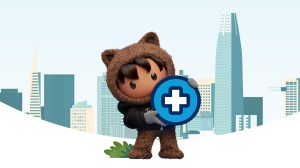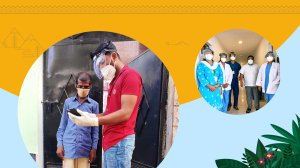At Salesforce we believe technology is a powerful tool to accelerate private and public sector responses to COVID-19. To that end, we recently released Work.com, a suite of new solutions and resources to help business and community leaders around the world reopen safely, re-skill employees and respond efficiently on the heels of the COVID-19 pandemic.
In this series, we’ll do a deeper dive into each of the Work.com capabilities: why we built them, how we built them, and how customers can leverage them in their response to COVID-19. This week, we’ll focus on our manual contact tracing solution for the public sector.
What is contact tracing for the public sector?
Salesforce’s Contact Tracing solution lets government organizations establish a manual contact tracing framework that allows officials to locate and inform people who may have been exposed to a pandemic by an infected person. States and local governments are able to establish a connected network of command centers on top of the Salesforce platform with the ability to manage large volumes of inbound and outbound communication. For citizens who test positive, or are showing symptoms, officials are able to coordinate the resources and personnel needed to ensure critical follow-up steps. These steps are essential for keeping the rest of the community safe.
Why it matters:
Across the globe, the public sector is facing the daunting task of slowing the spread of COVID-19 and protecting citizens. Given the highly infectious nature of COVID-19, it’s critical for state and local officials to be able to track the virus’ spread. They also need to be able to inform members of the community who have come into contact with an infected person in a timely manner.
To learn more about how many states and local governments are turning to Salesforce’s Contact Tracing solution as a key part of their relief efforts, we talked with one of our Salesforce Public Sector leaders: Casey Coleman, SVP, Global Public Sector Digital Transformation. Read on for the full interview.
Q. What are some of the challenges that state and local governments face in their respose to COVID-19?
We’ve been through health crises before, including SARS, Ebola, and H1N1, but those were largely localized. State and local governments are managing a crisis on a scale that really has not been previously experienced. This is global, and it’s affecting everyone. It’s not only a health crisis, but an economic crisis. So it’s a crisis that’s multifaceted and it calls upon the very best of state and local government services to mount effective responses.
Q. When did it become apparent that the public sector would need to overhaul how it traditionally handled contact tracing in order to effectively respond to this pandemic?
It became evident in March that a more modern approach to contact tracing was needed. Contact tracing itself is a relatively mature practice and has been used globally to effectively address outbreaks. The practice is well-known, but the technologies that support it have rapidly advanced.
The opportunity to employ technology differently was, in our experience, spearheaded by some of the smaller states like Rhode Island, where Governor Raimondo was really a visionary in understanding the need to take action quickly.
Previous to the partnership with Salesforce, Rhode Island used just paper-based contact tracing. You can imagine the manual effort. Just from one infected person, you might be talking to dozens of people that come in contact with that person and the scale of it rapidly becomes overwhelming. You have to write it down, then you have to enter it into a system and conduct an analysis. And then you have to go take more paper and contact the next set of people. That process is time-consuming, error-prone, and slow. It’s hard to find enough people to hire as contact tracers to be able to deal with this at scale.
The Salesforce platform has helped Rhode Island move quickly and scale up with a smaller number of contact tracers. Analytics are built directly into the platform to surface insights, make observations and provide recommendations, so you can track and be able to see graphically where you need to focus efforts.
That experience, and experiences with a few other Salesforce customers, started to create a successful pattern that we’re replicating with cities and states across the country.
Q. What was the product development process?
Salesforce just recently announced the general availability of our emergency response management (ERM) product. This product is built on the foundation of successful implementations with Rhode Island, Massachusetts, and other states. So it’s been highly iterative and fast moving.
As we observed a repeating pattern emerging across the state governments, we understood that this was something that needed to be productized. We worked closely between the sales organization and the product and technology organization, to take these learnings, feed them into our product development process, and create a product. The product is based on the work we did with the early movers in contact tracing.
Q. What about the Salesforce platform and past work in the public sector has enabled us to transition our core product to a contact tracing solution?
The COVID-19 outbreak exposed the need for digital services. This is the only way to take care of customers, constituents, residents, citizens, and employees.
The Salesforce platform is perfectly positioned for this kind of situation where speed matters. First of all, it has a low code and no code configuration capability. You can rapidly deploy new capabilities that are production-ready in days and weeks rather than months and years.
Secondly, a couple of the long lead time elements of putting anything into a public sector production environment are security and compliance. In Salesforce’s case, our platform is certified at the US Federal Government’s FedRAMP High level, so security and compliance is already built in. When a team needs to bring something into their environment, like contact tracing, they can take advantage of that existing built in security and compliance framework and get it into service much more quickly.
Q. Can you talk about how a state or city would implement Salesforce’s Contact Tracing solution?
There are three main components that a state or city needs to consider to launch contact tracing: technology, people and the process.
Let’s start with the technology. Our Salesforce platform has the manual contact tracing functionality support processes already built in. We have the technical expertise and cloud architecture, in addition to a partner network of experienced system integrators who can rapidly come in and provide support.
The second piece is people. The state or local government will need contact tracers. These are the people who are making the actual outreach to those who’ve been affected by COVID and need to go through quarantine, isolation, and recovery and the people they have interacted with.
The third piece is process. This is an interesting element because we’re talking about sensitive data, including health and other personal information. Information like this that is in a public trust needs to be secure and handled properly. People need to be trained and understand how to make appropriate use of that data that’s in compliance with health and regulatory standards. That’s another area where we bring expertise and can help state and local governments understand what has been done in the past. That way, they can model and replicate previously successful implementations.
Q. What are some keys to a successful contact tracing program for a public sector organization?
It needs to be clear who has authority when running the program, so that they have the ability to make decisions and take action. You can’t spread this program responsibility over a lot of different organizations and hope that they will collaborate successfully. It needs to start with a small team that has been granted the authority and the support from the governor or from the mayor.
You also need to connect with other state and city governments because the outbreak is not contained to one locality. As much as we’ve been quarantined and staying at home, people are still mobile. There’s still a need to coordinate across boundaries in adjoining states or in a metropolitan area with multiple city jurisdictions. The need to collaborate, share information and stay in contact with one another to work against the virus together is important.
Lastly, manual contact tracing remains the gold standard for dealing with a pandemic in this situation. We believe that people need to be at the center of this approach and that’s how we’ve designed our contact tracing solution. It needs to be people talking to people. The technology is a supporting element to help with scale, to help with security, to help with process automation and decision making with data.
Q. Are there any interesting learnings you arrived at during the process that will impact how you see the private and public sectors responding to future crises?
It’s already becoming clear that the COVID-19 outbreak is leading to some fundamental shifts and some positive transformational developments in government service delivery. The changes range from contact tracing to the arrival of other services like online unemployment portals. It has really exposed where governments need to make a pivot to digital-first mindset and service. I really think that coming out of this crisis we’re going to see just a real fundamental shift to digital transformation and moving to omni channel, self-service, virtual contact centers, a lot more use of data analytics and visualization to support decision making.
I think a lot of the technologies that have proven themselves out in this crisis are going to be our go to platforms in the future.
Q. Anything to add?
Government workers are on the front lines of every aspect of COVID response. They are caring for the vulnerable populations who are affected by the outbreak and leading the search for vaccines and cures. They are also dealing with the economic fallout and the need for unemployment and other social benefits.
So I just want to just say how grateful we are for those essential workers and the work they’re doing to take care of all of us. We appreciate it. We know that it’s at some cost, some sacrifice to them personally, and we just want to say thank you.
To learn more about Salesforce’s Contact Tracing solution, check out this page.





















